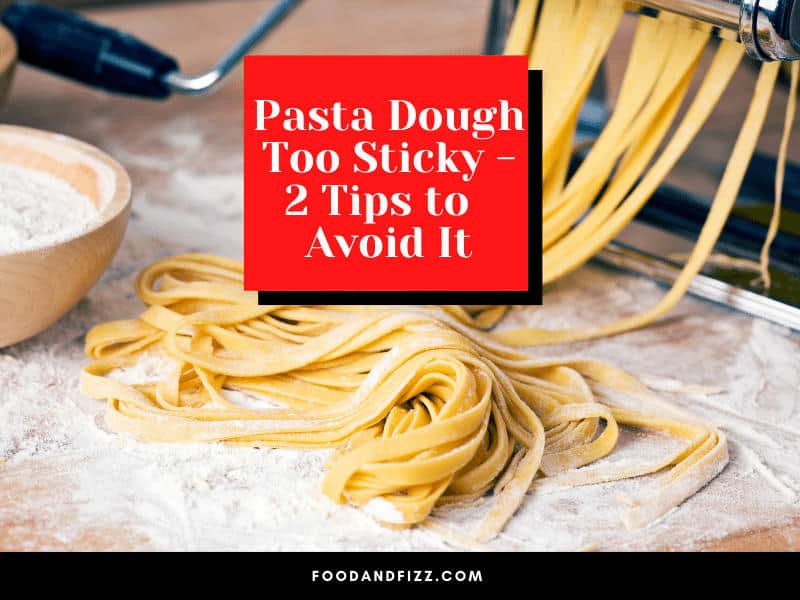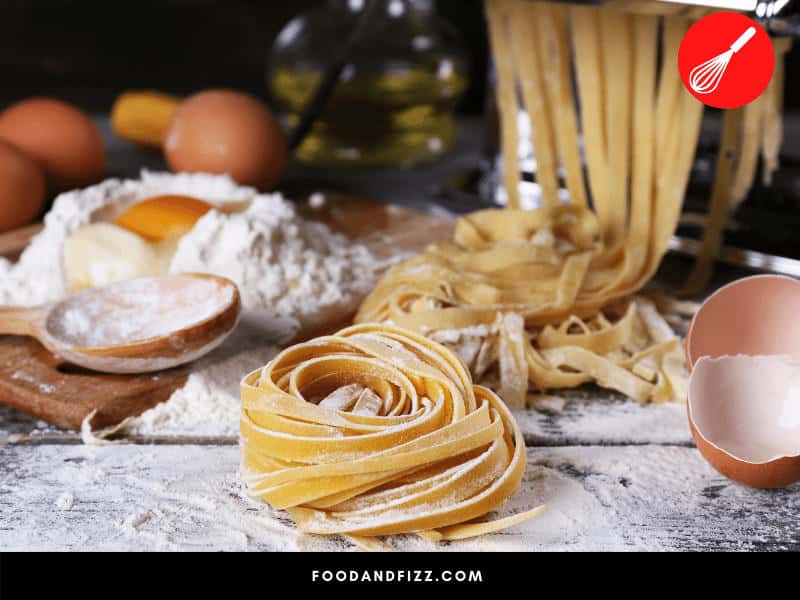Is your pasta dough too sticky? Too dry?
When making pasta dough, or any dough for that matter, it can be difficult to get a perfect consistency every single time. A lot of factors go into whether you get the consistency just right: the environment, the method, or the proportions in the recipe itself.
Thankfully, your less-than-perfect dough can often be remedied by following a few simple tips.
If the pasta dough feels too dry, there’s the option to add a little water to hydrate, though most cooks advise against that unless your ball of dough literally won’t clump together. If you absolutely have to, it is suggested to use a spray bottle so you don’t add too much that may potentially ruin your pasta dough.
If your pasta dough is too sticky on the other hand, there are several things you can do to make sure you still come up with a dough that’s workable and can be turned into delicious fresh pasta.
So, what do you do when your pasta dough is too sticky? Some tips below.
Pasta Dough Too Sticky – 2 Tips to Avoid it
If pasta dough is too sticky, you can either dust a little more flour in your dough or knead your dough more until it turns into a smooth and elastic ball. Pasta dough that’s too sticky may stick to the pasta machine and may be difficult to handle and shape. It’ll ruin your chances of making that wonderfully delicious fresh pasta you’ve always dreamed of.

What is Pasta?
Pasta is a kind of food that originated in Italy that is usually made with a dough of flour, water, and eggs. They are molded into different forms and cut into different shapes and cooked by boiling in water.
Once cooked, pasta should be properly drained. They are then tossed and served with different types of sauces ranging from mild oil-based sauces to meat-heavy, hearty accompaniments. Pasta is very versatile and can be easily adapted to fit different preferences. It will not surprise me at all if every single person in the world had at least one favorite pasta dish.
With its versatility and ease of preparation, it is no surprise then that pasta is such a beloved dish around the world.
How Different is Fresh Pasta from Dried Pasta?
Pasta has become such a universal food that you can get it almost anywhere. While fresh pasta may be harder to come by in terms of source, dried pasta can be purchased at any regular grocery store.
So, what’s the difference? How is fresh pasta different from dried pasta, and which one is better?
Both fresh pasta and dried pasta have flour and water as primary ingredients. However, what makes fresh pasta different is usually the presence of one single ingredient: eggs. That makes them slightly different in texture, and as we’ll see later on, this texture and quality make them more suitable for certain uses over others.
Advantages and Disadvantages of Fresh Pasta
Below are some advantages and disadvantages of fresh pasta.
Advantages
- Lighter texture and consistency
- Absorbs flavors and sauces
- You can choose to put healthier ingredients in your homemade fresh pasta
Disadvantages
- Depending on your skill level, it can be time-consuming to make. If buying outside, sources may be scarce.
- Because it is usually made with egg, it is not suitable for those with egg allergies or those who are following a plant-based diet
- It can go bad faster and it is much more difficult to store

Advantages and Disadvantages of Dried Pasta
Dried pasta, being commercially made and specifically produced to be shelf-stable, have advantages and disadvantages as well.
Advantages
- Convenient and easily available everywhere
- As it is usually made with just flour and water, it is suitable for vegans and those with egg allergies
- Has a longer shelf life
- As it is easy to store, you can store as many different types and shapes of pasta as can fit in your pantry
Disadvantages
- Takes a bit longer to cook compared to fresh pasta
- Can’t really replicate it at home
- Depending on the brand, it might taste commercial and generic
- You have no control over what ingredients are used and added

Pasta Dough is Too Sticky – 2 Tips to Avoid It
As with most things in the kitchen, making pasta is a skill that one acquires through lots of practice. Reading books and resources about how to make fresh pasta is great but rolling your sleeves up and getting your hands floured and ready to work is even better.
One of the more common problems in making fresh pasta is dough that’s too sticky. So, what do you do when you find yourself in this situation?
You can try these two tips.
1. Add more flour
If your dough is too sticky, you can sprinkle and knead more flour into your dough as you work it. It is important not to add too much though, as pasta dough needs to retain a little bit of its stickiness.
When you’re done kneading, the texture and feel should be like molding clay. Knead a small amount of flour at a time into your dough until it becomes drier and smoother. Do not dump big amounts of flour onto your dough, or you risk adding too much.
Sometimes the stickiness is due to not enough kneading, which brings us to the next tip.
2. Knead your dough a little bit more
Sometimes, pasta dough can be too sticky because it is not kneaded enough. You will know that you have kneaded enough when the texture of your dough becomes smooth, and it becomes elastic. When the dough is stretched, it should not easily tear off.

Now stickiness is not just a problem with raw pasta dough. It can also become an issue once you cook your pasta. To prevent your pasta from sticking to each other once its cooked, it is important to get the cooking time right, and to make sure they are rinsed in cold water prior to storing.
The article How to Stop Pasta Sticking Together Overnight – #1 Best Tip talks about this in great detail.
How to Avoid Dough That’s Too Dry
So, pasta dough that’s too sticky can be remedied with two simple tips. But what about pasta dough that’s too dry? What can be done?
Unless the dough is literally not holding together into a ball, it is usually not advisable to add water to pasta dough that’s too dry. Kneading the dough might actually help with it in most cases.
If you absolutely have to (in cases that it won’t form into a ball), some expert cooks recommend using a spray bottle which will allow you to add as little water as possible so that you only add enough for it to come together. The rest should be solved by kneading.
Tips on Making the Perfect Fresh Pasta
So, what are some important things to keep in mind to help us make that perfect batch of fresh pasta?
1. Use the right kind of flour
Pasta needs gluten for it to come together and hold its shape, so it is important to use the right type of flour in your fresh pasta. Usually, these three flour types are used: Semolina, “00” Flour, or All-Purpose.
Semolina flour is made from hard durum wheat, which means it is best for certain types of pasta with thicker and more complicated shapes such as penne or macaroni. It allows them to hold intricate designs and shapes better. Pasta that uses Semolina flour also holds sauces better.
“00” Flour is a finely ground soft wheat flour that is perfect for more delicate kinds of pasta like tagliatelle, or if you want pasta that’s more softer and tender.
All-Purpose flour is something most people would always readily have in their pantries, and it makes good pasta as well. It is generally lower in gluten content than Semolina, which means that you have to knead the dough a little longer for you to achieve the desired texture and consistency.
2. Right egg to flour ratio
The right flour to egg ratio will ensure your dough will get the right consistency and hydration and will help for it to turn out properly.
A good rule followed by most cooks is 1 egg (weighing 1 ¾ – 2 ounces or 50-55 grams) for every 3 ½ ounces (100 grams) of flour.

3. Knead enough
It is important to knead your dough enough for the gluten in the flour to develop and hold up the shape of your pasta. Gluten is also responsible for the springy and chewy texture of pasta that we all know and love, and this step is crucial in how pasta dough will turn out. Under-kneaded dough will not hold its shape, and worse, will fall apart.
4. Rest dough
Resting your pasta dough will allow it to absorb water and hydrate. It will also relax the gluten in the dough, and because of this, it will be easier to roll vs dough that’s not rested. Experts suggest at least half an hour of resting time and pretty much agree that this step should never be skipped.
Once you cook your pasta,
Conclusion to Pasta Dough Too Sticky – 2 Tips to Avoid It
Making pasta is a skill that anyone can learn and pick up through practice. Pasta dough that’s too sticky is not the end of the world – there are things you can do to remedy it such as adding more flour and kneading it a little bit more.
The beauty of cooking is, if you keep trying, you will eventually get it right, and a time will come when it will all be instinct. You’ll be able to make fresh, delicious pasta dough like you’ve been an expert all this time.
Frequently Asked Questions on Pasta Dough Too Sticky – 2 Tips to Avoid it
Is Fresh Pasta Better Than Dried Pasta?
Fresh pasta and dried pasta both have their advantages and disadvantages. Fresh pasta is usually better for delicate sauces, while dried pasta, for heavier, heartier sauces. Fresh pasta is lighter and can be made healthier, but in terms of convenience and ease of storage, dried pasta is better.
What Happens If I Put Too Much Flour in My Pasta Dough?
Putting too much flour in pasta dough will make it too tough and dry. Pasta dough should be a bit sticky (but not too much) like modeling clay.

